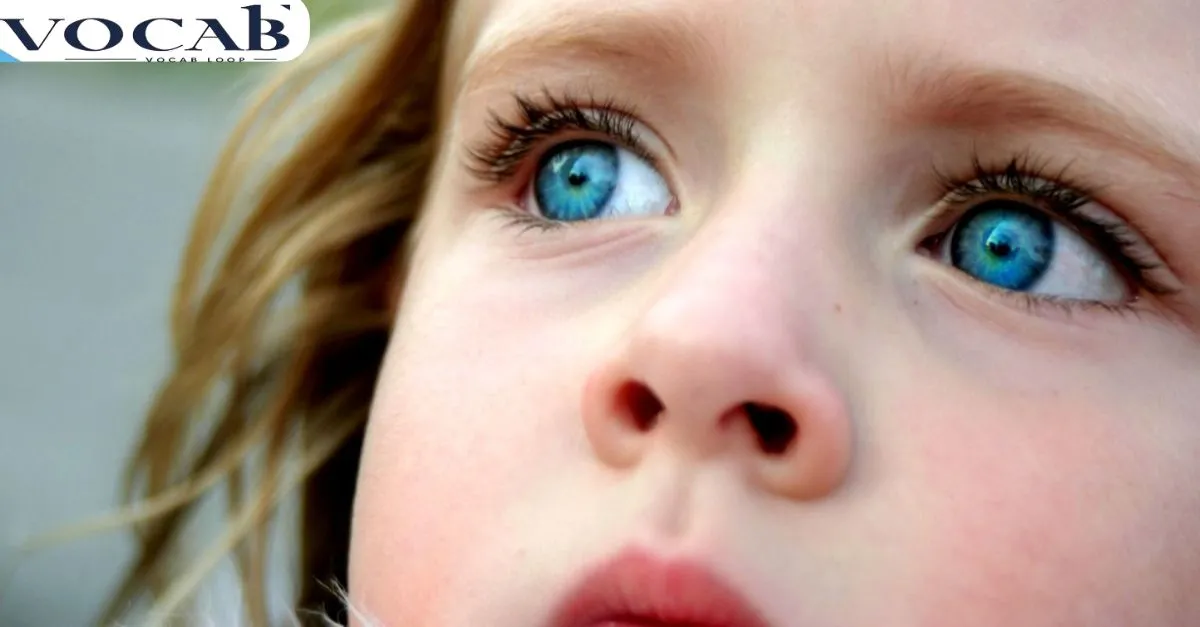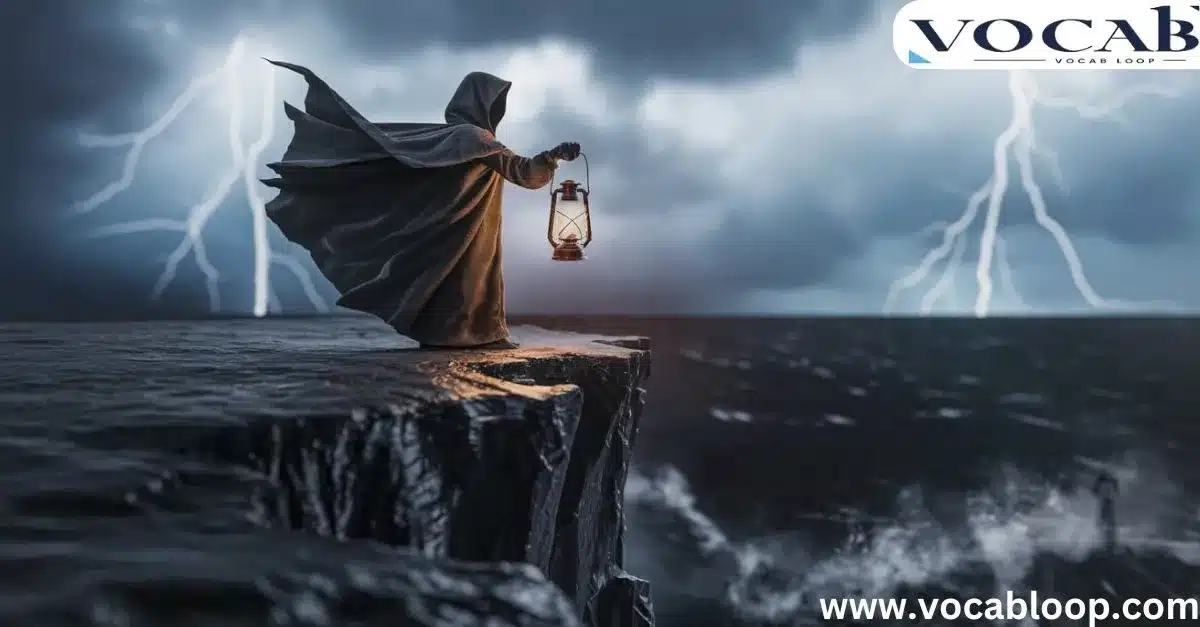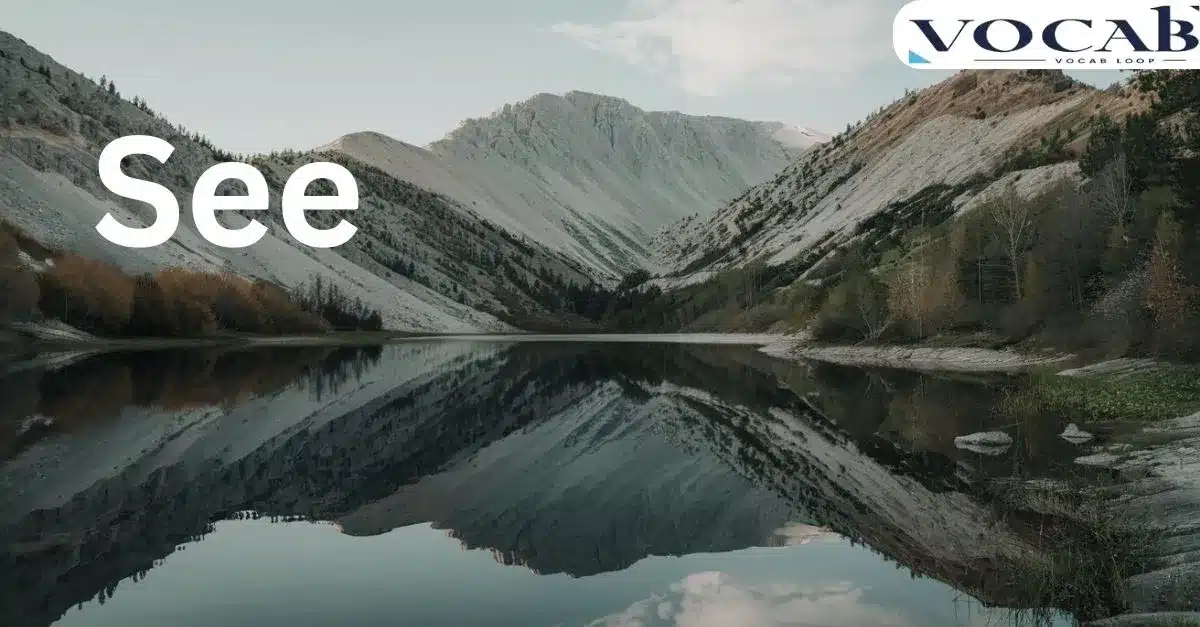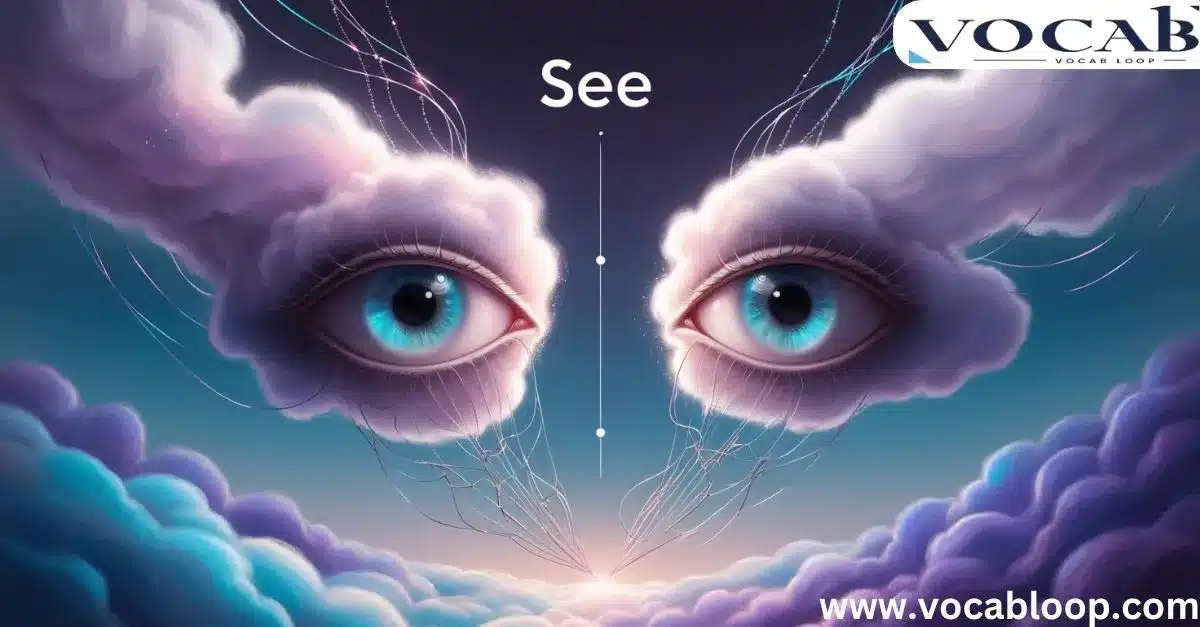The past tense of “see” is saw, and its past participle is seen. “Saw” is used for actions completed in the past, while “seen” is used with helping verbs like “have” or “had” to describe experiences or events that happened at an earlier time.
For example, you would say “I saw him yesterday” and “I have seen that movie before.” These forms are essential for creating clear timelines in both spoken and written English.
Definitions of “see”

- Perceive with the eyes: To become aware of something by using your sense of sight.
- Example: I can see the mountains from my window.
- Understand or realize: To comprehend or recognize something.
- Example: I see what you’re saying.
- Meet or visit someone: To spend time with someone, especially socially or for a specific purpose.
- Example: I’m going to see my friend tomorrow.
- Imagine or visualize: To form a mental picture of something.
- Example: I can see myself living in a small cottage someday.
- Experience or witness: To observe an event or situation.
- Example: She saw the accident happen.
- Consult: To refer to or seek guidance from someone, often for professional advice.
- Example: You should see a doctor about that cough.
Grammatical Forms
The verb “see” is one of the most ubiquitous and essential words in the English language. As a transitive verb, it describes the act of perceiving something visually or becoming aware of it through the sense of sight. Whether we’re observing the world around us, gaining knowledge, or recalling past experiences, the verb “see” plays a crucial role in our daily communication.
Understanding the proper conjugation of “see” in its past tense and past participle forms is paramount for crafting clear, grammatically correct sentences. In this comprehensive guide, we’ll delve into the nuances of these key verbal forms, exploring their definitions, usage, and the critical distinctions between them.
Past Tense vs. Past Participle: Unraveling the Difference

The past tense of “see” is “saw,” while the past participle is “seen.” Though these two forms may seem similar at first glance, they serve distinct grammatical purposes and require careful consideration to use them correctly.
The past tense of “see” is used to describe an action that occurred in the past, such as: “I saw the movie last night.” This form indicates that the action of seeing took place at a specific point in time.
In contrast, the past participle “seen” is used in various perfect tenses, such as the present perfect (“have seen”), past perfect (“had seen”), and future perfect (“will have seen”). These constructions describe an action that was completed before another past event or the present moment. For example: “I have seen that movie several times before.”
Mastering the proper usage of the past tense “saw” and the past participle “seen” is crucial for conveying the right meaning and avoiding common grammatical errors in your writing and speech.
The Mechanics: Conjugating the Verb “See”
The verb “see” belongs to the category of irregular verbs, meaning its past tense and past participle forms do not follow the standard “-ed” ending rule. Instead, “see” undergoes a unique conjugation pattern, which is important to understand and apply correctly.
Present Tense
In the present tense, the verb “see” has two forms:
- see (I/you/we/they)
- sees (he/she/it)
Past Tense
The simple past tense of “see” is “saw”:
- I saw the movie.
- She saw the painting in the museum.
- They saw the sunset over the ocean.
Future Tense
The future tense of “see” is formed with the helping verb “will”:
- I will see the concert next week.
- They will see the new exhibit when it opens.
Past Participle
The past participle of “see” is “seen”:
- I have seen that movie before.
- She had seen the painting several times.
- They will have seen the show by the time you arrive.
Understanding these conjugation patterns, including the distinction between the past tense “saw” and the past participle “seen,” is essential for using the verb “see” correctly in various sentence structures and tenses.
Proper Usage: Avoiding Common Mistakes

While the conjugation of “see” may seem straightforward, it’s easy to accidentally mix up the past tense and past participle forms, especially in more complex sentences. To help you use these verbal forms correctly, let’s examine some common mistakes and provide guidelines for proper usage.
Don’t Mix Up “Saw” and “Seen”
One of the most frequent errors is confusing the past tense “saw” with the past participle “seen.” For example:
- Incorrect: “I have saw the movie before.”
- Correct: “I have seen the movie before.”
Keep Tenses Consistent
Ensure that you’re using the appropriate tense for the context of your sentence. For instance:
- Correct: “I saw the movie last night.”
- Correct: “I have seen the movie several times before.”
- Incorrect: “I have saw the movie last night.”
Recognize Irregular Conjugation
Remember that “see” is an irregular verb, so its past tense and past participle forms do not follow the standard “-ed” ending rule. This means you can’t simply add “-ed” to the base form “see” to create the past tense or past participle.
Utilize Perfect Tenses Correctly
When using the past participle “seen,” be mindful of constructing the proper perfect tense constructions, such as the present perfect, past perfect, and future perfect:
- Present Perfect: “I have seen the movie before.”
- Past Perfect: “She had seen the painting several times.”
- Future Perfect: “By the time you arrive, they will have seen the exhibit.”
Avoid Mixing Up Progressive and Continuous Tenses
In addition to the simple past tense and past participle, “see” can also be conjugated in various progressive and continuous tenses. Be careful not to confuse these forms:
- Past Progressive: “I was seeing the doctor regularly.”
- Past Continuous: “They were seeing the sights of the city during their vacation.”
By consistently applying these guidelines and recognizing the nuances of the past tense and past participle of “see,” you can confidently and accurately incorporate this vital verb into your written and spoken communication.
Practical Examples: Demonstrating Proper Usage

To further solidify your understanding, let’s examine some real-world examples that illustrate the correct usage of the past tense and past participle of “see”:
Simple Past Tense
- “I saw the sunset over the ocean last night, and it was absolutely breathtaking.”
- “She saw the new exhibit at the museum and was impressed by the attention to detail.”
- “They saw the concert and said it was one of the best performances they had ever witnessed.”
Past Participle
- “I have seen that movie several times, and it never fails to entertain me.”
- “By the time I arrived, they had already seen the latest episode of the popular TV series.”
- “Will you have seen the new product demonstration before our meeting tomorrow?”
Past Progressive and Continuous
- “I was seeing the doctor regularly for my condition, and she was monitoring my progress closely.”
- “They were seeing the sights of the city during their vacation, taking in all the historic landmarks and cultural attractions.”
These examples illustrate the proper usage of the past tense “saw” and the past participle “seen” in a variety of sentence structures and contexts. Pay close attention to the verb forms and how they are used to convey the appropriate meaning and timeline of the actions described.
Mastering the Verbal Forms of “See”
The verb “see” has five primary verbal forms:
- see (present tense)
- saw (simple past tense)
- seen (past participle)
- seeing (present participle)
- sees (present tense, 3rd person singular)
Understanding and correctly applying these five forms is crucial for effectively communicating in English. Whether you’re recounting past experiences, describing ongoing actions, or referring to completed events, being able to select the appropriate verbal form of “see” will enhance the clarity and precision of your language.
Origins of see
The verb “see” has a rich history, tracing its roots back to the Old English word “sēon,” which was derived from the Proto-Germanic root “*sewhanan.” Over time, this versatile verb has evolved to become a fundamental part of the English language, with a wide range of meanings and applications.
Synonyms of see
In addition to the verb “see,” there are numerous synonyms that can be used to convey similar meanings, such as:
- Observe
- Witness
- Notice
- Perceive
- Behold
- Discern
- Regard
- Detect
While these synonyms may share some similarities with “see,” each word carries its own unique nuances and connotations. Carefully selecting the most appropriate synonym can help you express your ideas with greater precision and clarity.
FAQs
Can “seen” be used without “have” or “had”?
No, “seen” requires a helping verb like “have” or “had” to form correct sentences.
Is “see” only about vision?
No, it also conveys meanings like understanding, meeting people, or experiencing events.
What idioms use “see”?
Examples include “see eye to eye” (agree), “see the light” (understand), and “wait and see” (observe outcomes).
What does “seeing” mean in phrases?
It often means “considering” or “acknowledging,” e.g., “Seeing that it’s raining, let’s stay inside.”
How does “see” vary in tone?
Formally, it can mean consulting or referencing, while informally, it relates to meeting or perceiving experiences.
Conclusion:
Mastering the past tense and past participle of the verb “see” is a crucial step in enhancing your command of the English language. By understanding the distinct uses of “saw” and “seen,” as well as the broader conjugation patterns of this irregular verb, you can communicate with greater accuracy, clarity, and confidence.
Whether you’re a student, a professional writer, or simply someone who wants to improve their language skills, this comprehensive guide has provided you with the knowledge and tools necessary to effectively wield the power of “see” in your written and spoken expression.

Alex Hormozi is a seasoned blogger at Vocab Loop, known for his deep insights into language, vocabulary, and grammar. With years of experience in writing, Alex shares practical tips and effective strategies to help readers improve their linguistic skills and enhance their writing abilities.

